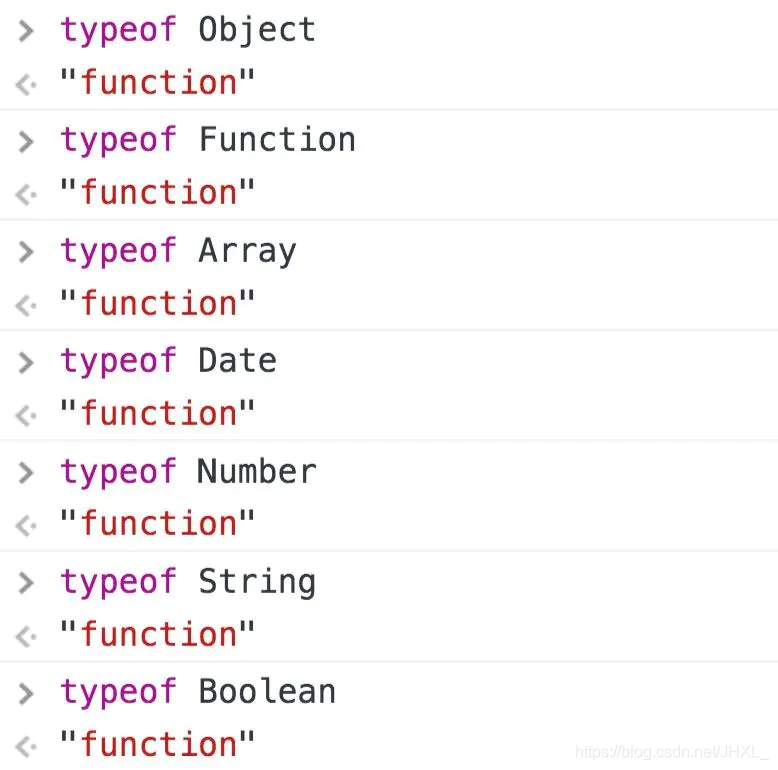文章目录
- 一. 普通对象与函数对象
- 二. 构造函数
- 三. 原型对象
- 四. proto
- 五. 构造器
- 六. 原型链
- 七. Prototype
- 总结
一. 普通对象与函数对象
JavaScript 中,万物皆对象!但对象也是有区别的。分为普通对象和函数对象,Object 、Function 是 JS 自带的函数对象。下面举例说明
var o1 = {};
var o2 =new Object();
var o3 = new f1();function f1(){};
var f2 = function(){};
var f3 = new Function('str','console.log(str)');console.log(typeof Object); //function
console.log(typeof Function); //function console.log(typeof f1); //function
console.log(typeof f2); //function
console.log(typeof f3); //function console.log(typeof o1); //object
console.log(typeof o2); //object
console.log(typeof o3); //object
在上面的例子中 o1 o2 o3 为普通对象,f1 f2 f3 为函数对象。怎么区分,其实很简单,凡是通过 new Function() 创建的对象都是函数对象,其他的都是普通对象。f1,f2,归根结底都是通过 new Function()的方式进行创建的。Function Object 也都是通过 New Function()创建的。
一定要分清楚普通对象和函数对象,下面我们会常常用到它。
二. 构造函数
我们先复习一下构造函数的知识:
function Person(name, age, job) {this.name = name;this.age = age;this.job = job;this.sayName = function() { alert(this.name) }
}
var person1 = new Person('Zaxlct', 28, 'Software Engineer');
var person2 = new Person('Mick', 23, 'Doctor');
上面的例子中 person1 和 person2 都是 Person 的实例。这两个实例都有一个 constructor (构造函数)属性,该属性(是一个指针)指向 Person。 即:
console.log(person1.constructor == Person); //trueconsole.log(person2.constructor == Person); //true
我们要记住两个概念(构造函数,实例):person1 和 person2 都是 构造函数 Person 的实例一个公式:实例的构造函数属性(constructor)指向构造函数。
三. 原型对象
在 JavaScript 中,每当定义一个对象(函数也是对象)时候,对象中都会包含一些预定义的属性。其中每个函数对象都有一个prototype 属性,这个属性指向函数的原型对象。(先用不管什么是 proto 第二节的课程会详细的剖析)
function Person() {}
Person.prototype.name = 'Zaxlct';
Person.prototype.age = 28;
Person.prototype.job = 'Software Engineer';
Person.prototype.sayName = function() {alert(this.name);
}var person1 = new Person();
person1.sayName(); // 'Zaxlct'var person2 = new Person();
person2.sayName(); // 'Zaxlct'console.log(person1.sayName == person2.sayName); //true
我们得到了本文第一个「定律」:每个对象都有 proto 属性,但只有函数对象才有 prototype 属性
那什么是原型对象呢? 我们把上面的例子改一改你就会明白了:
Person.prototype = {name: 'Zaxlct',age: 28,job: 'Software Engineer',sayName: function() {alert(this.name);}
}
原型对象,顾名思义,它就是一个普通对象(废话 = =!)。从现在开始你要牢牢记住原型对象就是 Person.prototype ,如果你还是害怕它,那就把它想想成一个字母 A: var A = Person.prototype
在上面我们给 A 添加了 四个属性:name、age、job、sayName。其实它还有一个默认的属性:constructor
在默认情况下,所有的原型对象都会自动获得一个 constructor(构造函数)属性,这个属性(是一个指针)指向 prototype 属性所在的函数(Person)
上面这句话有点拗口,我们「翻译」一下:A 有一个默认的 constructor 属性,这个属性是一个指针,指向 Person。即:Person.prototype.constructor == Person
在上面第二小节《构造函数》里,我们知道实例的构造函数属性(constructor)指向构造函数 :person1.constructor == Person
这两个「公式」好像有点联系:
person1.constructor == Person
Person.prototype.constructor == Person
person1 为什么有 constructor 属性?那是因为 person1 是 Person 的实例。 那 Person.prototype 为什么有 constructor 属性??同理, Person.prototype (你把它想象成 A) 也是Person 的实例。 也就是在 Person 创建的时候,创建了一个它的实例对象并赋值给它的 prototype,基本过程如下:
var A = new Person();Person.prototype = A;
// 注:上面两行代码只是帮助理解,并不能正常运行
结论:原型对象(Person.prototype)是 构造函数(Person)的一个实例。
原型对象其实就是普通对象(但 Function.prototype 除外,它是函数对象,但它很特殊,他没有prototype属性(前面说道函数对象都有prototype属性))。看下面的例子:
function Person(){};console.log(Person.prototype) //Person{}console.log(typeof Person.prototype) //Objectconsole.log(typeof Function.prototype) // Function,这个特殊console.log(typeof Object.prototype) // Objectconsole.log(typeof Function.prototype.prototype) //undefined
Function.prototype 为什么是函数对象呢?
var A = new Function ();Function.prototype = A;
上文提到凡是通过 new Function( ) 产生的对象都是函数对象**。因为 A 是函数对象,所以Function.prototype 是函数对象。
那原型对象是用来做什么的呢?主要作用是用于继承。举个例子:
var Person = function(name){this.name = name; // tip: 当函数执行时这个 this 指的是谁?};Person.prototype.getName = function(){return this.name; // tip: 当函数执行时这个 this 指的是谁?}var person1 = new person('Mick');person1.getName(); //Mick
从这个例子可以看出,通过给 Person.prototype 设置了一个函数对象的属性,那有 Person 的实例(person1)出来的普通对象就继承了这个属性。具体是怎么实现的继承,就要讲到下面的原型链了。
小问题,上面两个 this 都指向谁?
var person1 = new person('Mick');person1.name = 'Mick'; // 此时 person1 已经有 name 这个属性了person1.getName(); //Mick
故两次 this 在函数执行时都指向 person1。
四. proto
JS 在创建对象(不论是普通对象还是函数对象)的时候,都有一个叫做__proto__ 的内置属性,用于指向创建它的构造函数的原型对象。 对象 person1 有一个 __proto__属性,创建它的构造函数是 Person,构造函数的原型对象是 Person.prototype ,所以:person1.proto == Person.prototype
Person.prototype.constructor == Person;
person1.__proto__ == Person.prototype;
person1.constructor == Person;
不过,要明确的真正重要的一点就是,这个连接存在于实例(person1)与构造函数(Person)的原型对象(Person.prototype)之间,而不是存在于实例(person1)与构造函数(Person)之间。
注意:因为绝大部分浏览器都支持__proto__属性,所以它才被加入了 ES6 里(ES5 部分浏览器也支持,但还不是标准)。
五. 构造器
熟悉 Javascript 的童鞋都知道,我们可以这样创建一个对象:var obj = {}它等同于下面这样:var obj = new Object()
obj 是构造函数(Object)的一个实例。所以:obj.constructor === Objectobj.proto === Object.prototype
新对象 obj 是使用 new 操作符后跟一个构造函数来创建的。构造函数(Object)本身就是一个函数(就是上面说的函数对象),它和上面的构造函数 Person 差不多。只不过该函数是出于创建新对象的目的而定义的。所以不要被 Object 吓倒。
同理,可以创建对象的构造器不仅仅有 Object,也可以是 Array,Date,Function等。 所以我们也可以构造函数来创建 Array、 Date、Function
var b = new Array();
b.constructor === Array;
b.__proto__ === Array.prototype;var c = new Date();
c.constructor === Date;
c.__proto__ === Date.prototype;var d = new Function();
d.constructor === Function;
d.__proto__ === Function.prototype;
这些构造器都是函数对象:

函数对象
六. 原型链
小测试来检验一下你理解的怎么样:
- person1.proto 是什么?
- Person.proto 是什么?
- Person.prototype.proto 是什么?
- Object.proto 是什么?
- Object.prototype__proto__ 是什么?
答案: 第一题: 因为 person1.proto === person1 的构造函数.prototype因为 person1的构造函数 === Person所以 person1.proto === Person.prototype
第二题: 因为 Person.proto === Person的构造函数.prototype因为 Person的构造函数 === Function所以 Person.proto === Function.prototype
第三题:Person.prototype 是一个普通对象,我们无需关注它有哪些属性,只要记住它是一个普通对象。 因为一个普通对象的构造函数 === Object 所以 Person.prototype.proto === Object.prototype
第四题,参照第二题,因为 Person 和 Object 一样都是构造函数
第五题:Object.prototype 对象也有proto属性,但它比较特殊,为 null 。因为 null 处于原型链的顶端,这个只能记住。Object.prototype.proto === null
七. Prototype
在 ECMAScript 核心所定义的全部属性中,最耐人寻味的就要数 prototype 属性了。对于 ECMAScript 中的引用类型而言,prototype 是保存着它们所有实例方法的真正所在。换句话所说,诸如 toString()和 valuseOf() 等方法实际上都保存在 prototype 名下,只不过是通过各自对象的实例访问罢了。
——《JavaScript 高级程序设计》第三版 P116
我们知道 JS 内置了一些方法供我们使用,比如: 对象可以用 constructor/toString()/valueOf() 等方法; 数组可以用 map()/filter()/reducer() 等方法; 数字可用用 parseInt()/parseFloat()等方法; Why ???
当我们创建一个函数时:
var Person = new Object()Person 是 Object 的实例,所以 Person 继承了Object 的原型对象Object.prototype上所有的方法:

Object 的每个实例都具有以上的属性和方法。所以我可以用 Person.constructor 也可以用 Person.hasOwnProperty。
当我们创建一个数组时:
var num = new Array()num 是 Array 的实例,所以 num 继承了Array 的原型对象Array.prototype上所有的方法:

我们可以用一个 ES5 提供的新方法:Object.getOwnPropertyNames获取所有(包括不可枚举的属性)的属性名不包括 prototy 中的属性,返回一个数组:
var arrayAllKeys = Array.prototype; // [] 空数组
// 只得到 arrayAllKeys 这个对象里所有的属性名(不会去找 arrayAllKeys.prototype 中的属性)
console.log(Object.getOwnPropertyNames(arrayAllKeys));
/* 输出:
["length", "constructor", "toString", "toLocaleString", "join", "pop", "push",
"concat", "reverse", "shift", "unshift", "slice", "splice", "sort", "filter", "forEach",
"some", "every", "map", "indexOf", "lastIndexOf", "reduce", "reduceRight",
"entries", "keys", "copyWithin", "find", "findIndex", "fill"]
*/
这样你就明白了随便声明一个数组,它为啥能用那么多方法了。
细心的你肯定发现了Object.getOwnPropertyNames(arrayAllKeys) 输出的数组里并没有 constructor/hasOwnPrototype等对象的方法(你肯定没发现)。 但是随便定义的数组也能用这些方法
var num = [1];
console.log(num.hasOwnPrototype()) // false (输出布尔值而不是报错)
因为Array.prototype 虽然没这些方法,但是它有原型对象(proto):
// 上面我们说了 Object.prototype 就是一个普通对象。Array.prototype.proto == Object.prototype
所以 Array.prototype 继承了对象的所有方法,当你用num.hasOwnPrototype()时,JS 会先查一下它的构造函数 (Array) 的原型对象 Array.prototype 有没有有hasOwnPrototype()方法,没查到的话继续查一下 Array.prototype 的原型对象 Array.prototype.__proto__有没有这个方法。
当我们创建一个函数时:
var f = new Function("x","return x*x;");
//当然你也可以这么创建 f = function(x){ return x*x }
console.log(f.arguments) // arguments 方法从哪里来的?
console.log(f.call(window)) // call 方法从哪里来的?
console.log(Function.prototype) // function() {} (一个空的函数)
console.log(Object.getOwnPropertyNames(Function.prototype)); /* 输出
["length", "name", "arguments", "caller", "constructor", "bind", "toString", "call", "apply"]
*/
我们再复习这句话:
所有函数对象****proto都指向 Function.prototype,它是一个空函数(Empty function)
嗯,我们验证了它就是空函数。不过不要忽略前半句。我们枚举出了它的所有的方法,所以所有的函数对象都能用,比如:

如果你还没搞懂啥是函数对象?
还有,我建议你可以再复习下为什么:
Function.prototype 是唯一一个typeof XXX.prototype为 “function”的prototype
总结
原型和原型链是JS实现继承的一种模型。
原型链的形成是真正是靠__proto__ 而非prototype
要深入理解这句话,我们再举个例子,看看前面你真的理解了吗?
var animal = function(){};var dog = function(){};animal.price = 2000;dog.prototype = animal;var tidy = new dog();console.log(dog.price) //undefinedconsole.log(tidy.price) // 2000
这里解释一下:
var dog = function(){};dog.prototype.price = 2000;var tidy = new dog();console.log(tidy.price); // 2000console.log(dog.price); //undefinedvar dog = function(){};var tidy = new dog();tidy.price = 2000;console.log(dog.price); //undefined
这个明白吧?想一想我们上面说过这句话:
实例(tidy)和
原型对象(dog.prototype)存在一个连接。不过,要明确的真正重要的一点就是,这个连接存在于实例(tidy)与构造函数的原型对象(dog.prototype)之间,而不是存在于实例(tidy)与构造函数(dog)之间。
来源:https://mp.weixin.qq.com/s/jCjb-91X3q7_5AEGy71D0g



 导出出现无法访问已关闭的流)



![[Pytorch]Pytorch的tensor变量类型转换](http://pic.xiahunao.cn/[Pytorch]Pytorch的tensor变量类型转换)




搭建高可用服务注册中心)
_闭包)





